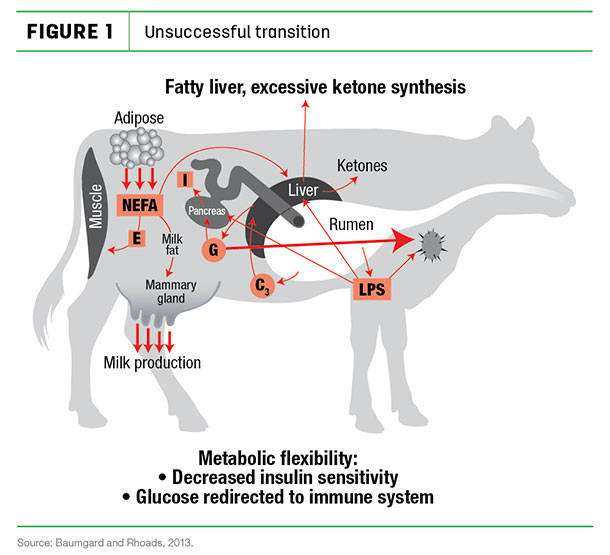“What do heat stress in dairy cows and ketosis have in common? Leaky gut syndrome (LGS),” Lance Baumgard, professor of animal science at Iowa State University, says.
“The origin of heat stress issues in all farm animals has definitely compromised intestinal integrity.” His research group, led by Ph.D. graduate student Sara Kvidera, has also discovered that poor transition cow performance may also be caused by LGS.
LGS can broadly be defined as the inability of the intestinal barrier to prevent unwanted molecules inside of the intestine from entering into the body. The intestines are lined with small finger-like projections called villi. The villi significantly increase the surface area so there is more efficient absorption of nutrients into the bloodstream.
The gastrointestinal tract is a tube running from the mouth to the anus. Technically, everything that is “inside the tube” remains “outside” of the animal’s body, as the tube keeps what is in the digestive tract separated from the rest of the body. One of its obvious responsibilities is to digest and absorb valuable nutrients.
But an additional and critically important job is to act as a barrier to prevent parasites, pathogens, enzymes, acids and toxins (which are normal and ubiquitous within the tract) from entering the rest of the body, Baumgard says.
Milk production goes down during both heat stress and ketosis. Baumgard noted decreased feed intake only accounts for about 50 percent of the decrease in productivity during heat stress. Both heat stress and ketosis are characterized by negative energy balance, bodyweight loss, inflammation and fatty liver disease.
“While the metabolism of ketosis and heat stress has been thoroughly studied for the last 40 years, the initial insult in the cascade of events ultimately reducing productivity in both heat-stressed and ketotic cows has not been identified. The negative impacts of both of them are as severe as they were years ago."
"To that end, we have generated preliminary data strongly implicating a metabolic disruptor, endotoxin, as the etiological culprit in each case,” he says. (An endotoxin is a toxic substance bound to the bacterial cell wall and released when the bacterium ruptures or disintegrate.)
Research has discovered cows that develop ketosis have elevated levels of this endotoxin up to two weeks before calving.
Feed intake below optimum level by itself can also negatively affect intestinal barrier function, and of course inadequate feed intake is a hallmark of both heat-stressed and ketotic cows. Baumgard says, “So it is not likely a coincidence that heat-stressed and ketotic cows have similar metabolic and endocrine [hormonal] fingerprints. Leaky gut is a common denominator in both.”
During heat stress, a cow’s blood flow is directed outward to her skin and extremities to help cool her body, which can leave the intestines wanting for oxygenated blood.
“This results in increased intestinal permeability, which allows foreign substances to enter the body, and this stimulates an immune response that includes inflammation,” Baumgard says. “The immune response utilizes nutrients that would normally have been used for the synthesis of milk.
“Thus, the origin of decreased production and poor reproduction during heat stress appears to be at the intestine,” Baumgard says. He added that up to 70 percent of the immune response resides in the gastrointestinal tract.
A similar process may happen during ketosis. “We have also discovered that biomarkers of leaky gut are closely associated with the development of ketosis.
Therefore, our data has led us to question the dogma that ketosis is caused by excessive fatty tissue mobilization and that other things likely contribute to poor transition cow performance other than high NEFA [non-esterified fatty acids] and ketones,” Baumgard says.
Baumgard and others believe the increased likelihood of leaky gut in transition cows may be linked to a dietary shift of increased concentrates. This can cause rumen acidosis and increased starch delivery to the large intestine. Excessive starch fermentation in the large intestine causes “hindgut” gut acidosis, a phenomenon that causes LGS.
The consequence of LGS in both heat-stressed and ketotic cows is that the immune system becomes activated (Figure 1).

The activated immune system then utilizes nutrients that would normally be destined for the production of milk. At rest, immune cells can oxidize multiple fuels, but once they are activated by an immune response, they begin using glucose. The immune system uses glucose due to leaky gut, and glucose is a precursor to lactose.
“The mammary gland’s synthesis of lactose is the primary determining factor of overall milk yield. So anything that alters the hierarchy of glucose use (i.e., the immune system) reduces glucose availability for the making of milk,” Baumgard says.
Interestingly, heat-stressed and ketotic animals have higher levels of insulin than expected. Baumgard’s students discovered that endotoxin stimulates the pancreas to secrete increased amounts of insulin. This is biologically unusual because animals that eat less (ketotic and heat-stressed cows) normally have low levels of insulin.
“Increased insulin is not conductive for maximizing milk synthesis,” Baumgard says. “This hormone is anti-milk, as it promotes dietary nutrients toward adipose tissue and muscle and away from milk synthesis.” He continues, “High milk production is dependent upon low insulin and decreased insulin sensitivity."
"In my opinion, we want dietary strategies that reduce insulin action and thus partition a greater percentage of dietary nutrients toward milk production.”
Other events that can lead to inadequate feed intake and possibly lead to a compromised intestinal integrity include weaning, shipping, overcrowding and unpalatable feed.
“Strategies that can improve intestinal integrity need to be researched,” says Baumgard. “If leaky gut is the fundamental cause of many typical on-farm problems including heat stress and ketosis, then it is a financial problem that dwarfs most others combined.”
He adds that if we have a better understanding of why heat stress and ketosis occur, we have better chances of resolving it. ![]()
Kelli Boylen is a freelance writer from Waterville, Iowa









